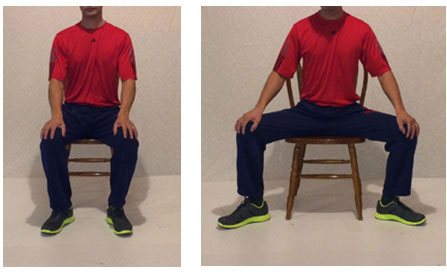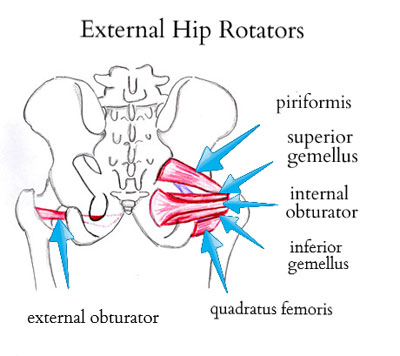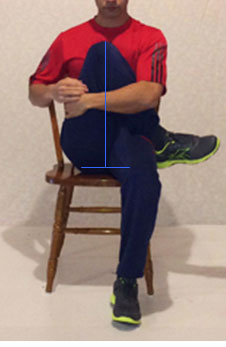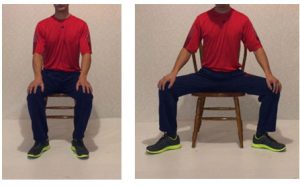Pain in Hip Rotator Hip Flexor Carrying Baby
Is your hip pain from tight rotator muscles?
Follow these 2 simple exercises to ease your pain

Hip rotators allow you to open your legs outward
Updated May 7, 2020 | Sherwin Nicholson
Hip muscle pain is pretty common, especially if you sit down for hours. You know you have it if you feel it deep within your buttock area. And it gets worse the longer that you sit for. The problem is from the muscles themselves. Your hip rotators.
These muscles are responsible for the external rotation of the leg outwards and to the side of the body. You can experience this simply by sitting and spreading your knees apart as wide as possible.
Try to practice the movement in the images above to feel your rotators in action now.
When you have this kind of discomfort, there is a deep, dull, aching sensation in the buttock areas when you sit, stand or walk.
When you have this kind of discomfort, there is a deep, dull, aching sensation in the buttock areas when you sit, stand or walk.
A good sign that it's the rotators, is by rubbing this area of your buttock. If it feels worse, it's them.
Don't neglect them or it'll hurt more!
You usually won't notice these muscles until they start to flare up on you.
Too much sitting and little stretching is why these muscles not only become weak and short but also tight and sore. By applying pressure with your knuckles, you will inadvertently stretch an already tight, weak, muscle and worsen the symptoms.
Most people may prefer massage as an option to help indirectly relax and lengthen the muscle but you're not really providing the stretch you need.
To be able to treat yourself, these muscles need a more extensive but simple method as you will see.
If you want to learn more about this muscle group read on, but if you just want to get to the exercise, then skip the short lesson and scroll down.

The External Rotators are also known as the lateral rotator group.
They include the:
Piriformis
Gemellus Superior
Gemellus Inferior
Obturator Externus
Obturator Internus
and Quadratus Femoris
These muscles each attach from the hip to the femur.
Our external rotators are very prone to becoming tight because they are constantly contracting. When we sit, pressure is placed on the muscles thereby reducing blood flow and nervous activity. You can develop a viscous cycle of pain as there is little opportunity for them to recover.
Severe Piriformis muscle discomfort is one of the most common complaints. It can become very sore, swollen, irritated when tight, and can press on your sciatic nerve which hurts.
The pressure creates either soreness, a numbing sensation or nerve tingling. The sensation can travel downstream along the back of the leg other either side depending on which muscle is affected.
An important cause of this discomfort is simply because these muscles are rarely rotated internally to lengthen them naturally. Internal rotators typically are not active enough to help stretch the external ones.
Tight external rotators create a standing posture and walking gait in which the knees are pointing outwards.
The changed position, therefore, affects the tilt of the pelvis. The pelvis tends to tilt towards posterior while standing, walking, sitting and lying down.
The result is imbalanced pressure on lumbar discs leading to a potential disc bulge posterior to the vertebrae. Chronic disc bulge may lead to disc rupture and chronic lower back injury.
To help solve this problem, follow these 2 exercises.
You need to allow your pelvis to tilt towards anterior into a neutral position, so an effective stretch is required.
1) The Seated leg to chest
Fortunately, here is one of the most important ones to perform. I call it the Seated Leg to Chest stretch.
It's pretty easy to do but does take time to master well. To be able to do it well, you must hold the position for at least 1 to 2 minutes. Anything less is insufficient and will not give you lasting relief.

The above image demonstrates the final position to achieve. Initially, it 's hard to bring the side of thigh fully against the stomach and chest. The key factor is that you are trying to force this tight muscle to release. Holding for over 1 minute is what you will need to do to make it happen.
You don't have to get your thigh right up to your chest. Just go as far as you can for now. In time, you'll get closer.
For full details, see the Seated Leg to Chest page.
Take your time with this stretch
You should be doing this stretch for several minutes per side daily. Because it stretches such a large group of muscles, you will need to stretch for many days to weeks to really get the full benefit. Because we sit on these muscles often every day, we need to stretch diligently.
To stretch sufficiently for lasting relief, it is important to hold the pose in the stretch properly. A few repetitions of stretching or a few seconds may feel like a good start, but a much longer duration is more beneficial. These muscles can require weeks to months of disciplined stretching to reach optimal length.
Even though you may feel better with some initial stretching, it is important to hold longer to really relieve your soreness.
2) The Seated leg opener

Yes, it's the same one as above.
The difference it that you need to perform this so that you are actively opening your legs as much as you can without assistance.
You need to strengthen the muscle because it is much too weak. Stretching is useless without strengthening also! We rarely do this movement so there is a very good chance that yours is truly weak.
Hold this pose for up to 30 seconds and alternate it with the seated leg to chest movement.
Ironically, you can make very good use out of all of that sitting that you have to do at work by doing these very exercises at the same time. Don't worry, it doesn't take much of your time.
The Seated Leg to Chest and Seated Leg Opener is only two of many important movements and stretches necessary for lasting relief.
I have designed a very extensive and helpful set of exercises along with an instructional guide for all those with back and hip problems. The more you do them, the easier it gets, and the better you will feel. You put in all the effort and reap all of the benefits.
"the ideas here apply to several forms of chronic pain, in my case my hip. Simple, easy to understand steps that have made a huge difference in pain management and improving quality of life – thank you sherwin, Reila S. Newmarket, Ontario, Canada"
MORE TESTIMONIALS AND REVIEWS
Download the program that will relieve your hip flexors
For more help:
Learn about your hips and hamstrings
Are your tight hips hurting?
Sore hips and what it does to your back
References:
- Physiotherapy and Rehabilitation for BP-http://www.ncbi.nlm.nih.gov/pubmed/23985153
- LBP – Eric R. Castillo Daniel E. Lieberman Evol Med Public Health (2015) 2015 (1): 2-3. DOI: https://doi.org/10.1093/emph/eou034 Published: 10 January 2015 https://academic.oup.com/emph/article/2015/1/2/1795271/Lbp
- The Wharton's Back Book – x2003. 617.564Wha. Emmaus, Pa. Rodale Inc. Wharton, Jim.
More references for this page
Pain in Hip Rotator Hip Flexor Carrying Baby
Source: https://lowbackpainprogram.com/hip-rotators-and-pain/
0 Response to "Pain in Hip Rotator Hip Flexor Carrying Baby"
Post a Comment